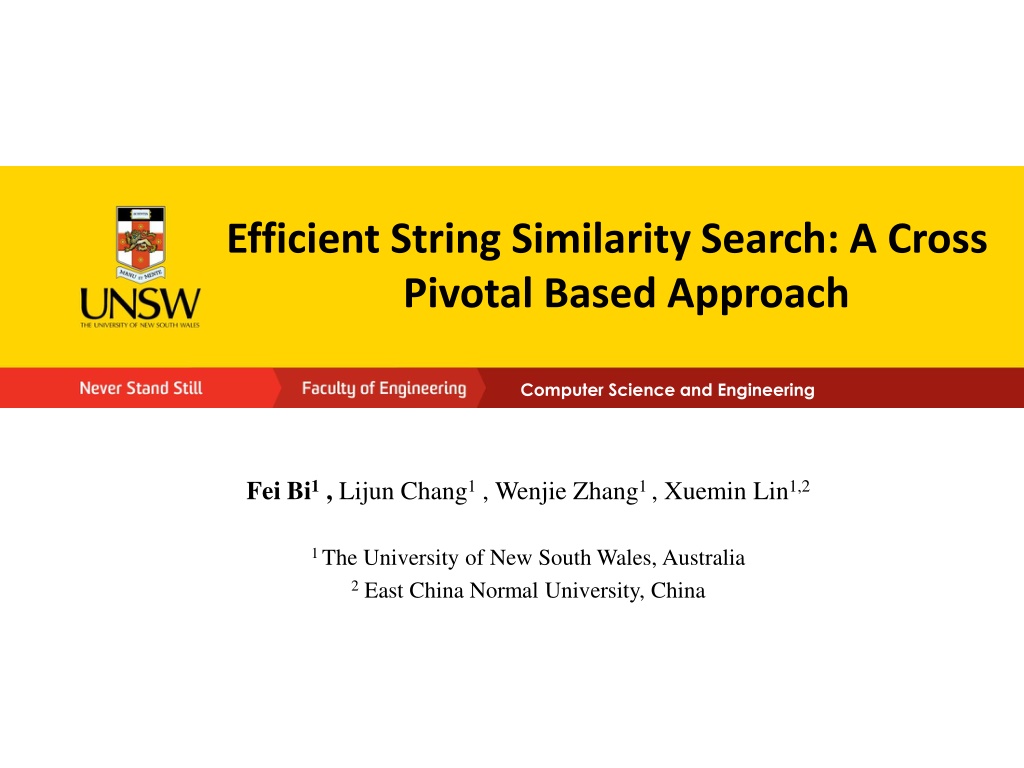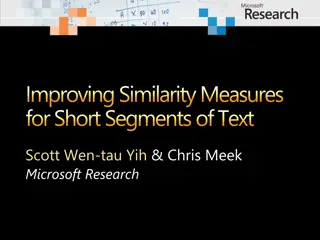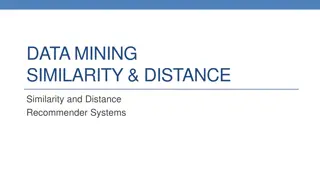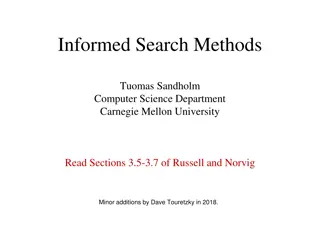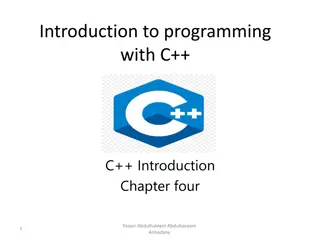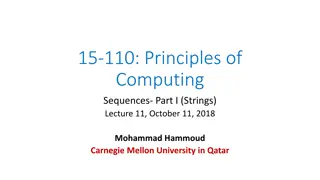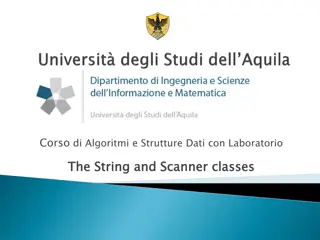Efficient String Similarity Search: A Cross Pivotal Approach in Computer Science and Engineering
Explore the importance of string similarity search in handling dirty data, with applications in duplicate detection, spelling correction, and bioinformatics. Learn about similarity measurement using edit distance and the challenge of time complexity in validation. Discover the filter-and-verification framework and the concept of Q-grams as signatures for efficient searching.
Download Presentation

Please find below an Image/Link to download the presentation.
The content on the website is provided AS IS for your information and personal use only. It may not be sold, licensed, or shared on other websites without obtaining consent from the author. Download presentation by click this link. If you encounter any issues during the download, it is possible that the publisher has removed the file from their server.
E N D
Presentation Transcript
Efficient String Similarity Search: A Cross Pivotal Based Approach Computer Science and Engineering Fei Bi1 , Lijun Chang1 , Wenjie Zhang1 , Xuemin Lin1,2 1 The University of New South Wales, Australia 2East China Normal University, China
Outline Background Our Approach Experimental Study 2
String Similarity Search Why do we need similarity search? Data in the real world could be dirty. (incomplete, noisy and inconsistent) Try to understand the relation among data sets. Applications of string similarity search Duplicate detection (i.e. TurnItIn). Spelling check or auto typing correction (i.e. Microsoft Words). Sequence alignment comparison in bioinformatics. 4
Similarity Measurement Edit distance Minimum number of edit operation required to transform one string into the other. Three types of edit operation: insertion, deletion, and substitution. Example s = datamining and r = datemnings To transform s into r: 1. Substitute a with e 2. Delete i 3. Insert s after g 5
Problem Definition String Similarity Search Query string r = yotubecom and = 2 ed(s, r) <= 2 Output youtbecom as a result string dataset S 6
Challenge Time complexity for validating edit distance with threshold ? min ? , ? Nav e Method Time complexity for each query ? ? min ? , ? 7
Filter-and-Verification Framework Query string r Dataset S Signatures Filter Index built on signatures Query Index Candidates Verification Validation Results 8
Signature: Q-Gram Q-gram is first proposed as a signature scheme by Gravano in 2001. Q-gram: A sequence of q characters of the original string. Example for q=3 vacation : vac, aca, cat, ati, tio, ion. Similar strings have many common q-grams. 9
Related work: Pivotal Prefix Pivotal q-gram set: a set of t + 1 disjoint q-grams selected from qt + 1 prefix of the q-gram set. Sort all q-grams by global ordering, such as idf q(r) : The sorted q-gram set of query string r Pre(r) Piv(r) |Piv(r)|= +1 and the q-grams in Piv(r) are disjoint 10
Related work: Pivotal Prefix Pre(r) last(r) Piv(s) last(s) Piv(r) Pre(s) Pivotal Prefix Filter: If last(r) < last(s) and piv(r) pre(s) = , ED(r,s) > If last(s) < last(r) and piv(s) pre(r) = , ED(r,s) > 11
Our Approach Cross Pivotal based pruning technique Min-Order based pivotal set selection method Two advanced filters: Position Match Filter Pivotal Substitution Filter 12
Advantages of Our Approach High pruning power Three pruning strategies are guaranteed to achieve least candidates among existing algorithms More effective method for pivotal set selection with reduced complexity Low memory consumption 13
Cross Pivotal Filter lpr: the position of the last pivotal q-gram q(r): Piv(r) = +1 disjoint q-grams q(s): If s and r are similar, then Piv(r) q(s) . If s and r are similar, then Piv(r) Prelpr + (q-1) (s) and Piv(s) Prelps + (q-1) (r) If s and r are similar, then Piv(r) Prelpr + (q-1) (s) . If r and s are similar, then Piv(s) Prelps + (q-1) (r) . Cross Pivotal Filter: Given any two strings s and r, if Piv(r) Prelpr + (q-1) (s) = or Piv(s) Prelps + (q-1) (r) = , then s and r cannot be similar. 14
Comparison of pruning power Our proposed cross pivotal filter possesses the strongest pruning power, compared to IndexChunk-Turbo [Qin TODS13], IndexGram-Turbo [Qin TODS13], and Pivotal Preifx [Deng SIGMOD 13] 15
Cross Pivotal Filter Suppose that we have two strings s and r: s = datamining r = datacleaning q(s) = {am, mi, da, ni, ng, ta, at, in, in} q(r) = {ac, cl, an, le, da, ea, ni, ng, ta, at, in} We select piv(s) ={am, da, ni} and piv(r) = {ac, an, le}; so we have : lps = 4 and the prefix length is lps + (q-1)t = 6; lpr = 4 and the prefix length is lpr + (q-1)t = 6. pre(s) = {am, mi, da, ni, ng, ta} pre(r) = {ac, cl, an, le, da, ea } Cross pivotal filter: piv(s) pre(r) = {da} and piv(r) pre(s) = 16
Overflow of our approach Build two indexes for pivotal and (2q-1) +1 prefix respectively Data string set S Offline Query string r Query the (2q-1) +1 prefix index with pivotal Query the pivotal index with (2q-1) +1 prefix Intersect to refine candidates Advanced filters Verification 17
MinOrder Based Pivotal Selection Objective Minimize lpr and lps to gain more pruning power lpr Goal Minimize the maximum order of the selected pivotal q-gram set Advantages: Effective: reduce the filtering cost Efficient: DP method with O(qt2), as opposed to O(q2t3) in previous works. 18
Single Match Candidate: Suppose there are five data strings {s1, s2, s3, s4, s5} and the pivotal set of query string r is piv(r) = {g1, g2, g3}. Using piv(r) to the query the inverted index of prefix, g1 retrieves s1, s3, s5 g2 retrieves s2, s3, s5 g3 retrieves s2, s5 s1 is retrieved by one and only one pivotal q-gram g1, so s1 is a single match candidate. 19
Single Match Candidates 50% - 95% of candidates are single match candidates. Very Unlikely to be the results. Two filters based on single match candidates: Pivotal Substitution Filter Position Match Filter 20
Experimental study Dataset Performance Evaluation Candidate number Processing time Algorithms: CrossPivotalSearch Pivotal Prefix IndexGramTurbo IndexChunkTurbo 21
Evaluation of Proposed Advanced Filters CrossPivotalSearch: Cross Pivotal filter + two advanced filters + verification CrossPivotalBasic: Cross Pivotal filter + verification 24
Thank you! Questions? 27
Pivotal Substitution Filter Our cross pivotal filter s pruning condition is Piv(s) Prelps + (q-1) (r) = or Piv(r) Prelpr + (q-1) (s) = To further increase the pruning power, a na ve way is using more pivotal sets of the query string r to query the Prelpr + (q-1) (s) . Piv(s) Prelps + (q-1) (r) = or Piv(r) Prelpr + (q-1) (s) = or Piv1(r) Prelpr1 + (q-1) (s) = or Piv2(r) Prelpr2 + (q-1) (s) = . Unfortunately, the filtering cost here is actually very high. So we need to find a balance between the pruning power and the filtering cost. 28
Pivotal Substitution Filter Example: piv(r) = {g1, g2, g3}. We can select another q-gram in g4 as the pivotal substitution of g1. Then, we actually have another pivotal set {g4, g2, g3}. Example: s1 is a single match candidate retrieved by g1 in piv(r). However, g1 s pivotal substitution g4 is not in q(s1). So s1 is pruned. 29
Position Match Filter i - 1 t + 1 - i 30
